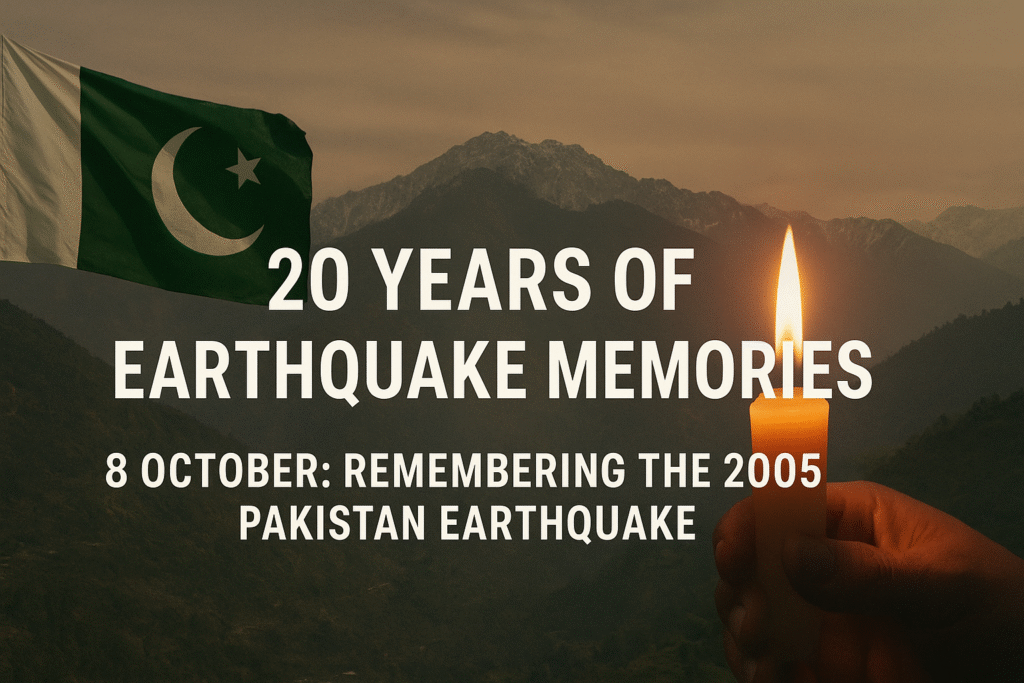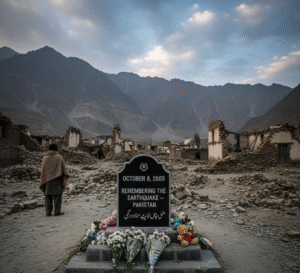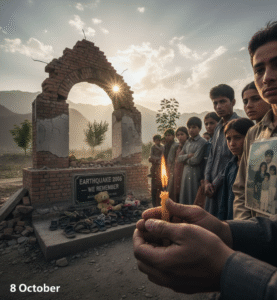8 October: Remembering the 20-Year Earthquake Memories in Pakistan

Introduction
Every year on 8 October, Pakistan pauses to remember one of the darkest mornings in its history — the 2005 Kashmir Earthquake, which forever changed the country’s landscape and the lives of millions. At exactly 8:50 a.m. on that tragic Saturday, a massive magnitude 7.6 earthquake struck northern Pakistan, devastating cities and villages across Azad Jammu and Kashmir, Khyber Pakhtunkhwa, and parts of Punjab and Islamabad.
Twenty years later, the memories remain vivid. Survivors still recount the moments when the ground shook violently, when schools crumbled, and when families were torn apart in seconds. It wasn’t just an earthquake; it was a national trauma that tested Pakistan’s resilience and revealed both its weaknesses and strengths in disaster response.
As the nation observes the 20-year anniversary of the 2005 earthquake, it’s important not only to mourn those who were lost but also to reflect on the progress, lessons, and challenges that continue to shape Pakistan’s disaster preparedness and recovery efforts. 8 October 2005 Earthquake Pakistan 20 year Earthquake Anniversary Kashmir Earthquake 2005 Pakistan Earthquake Memories Muzaffarabad Earthquake Balakot Earthquake Earthquake Preparedness Pakistan Disaster Resilience in Pakistan.

The Geological Setting and Causes
Why Northern Pakistan Is So Vulnerable
Northern Pakistan lies at the collision boundary between the Indian and Eurasian tectonic plates. This region — stretching from the Himalayas to the Hindu Kush — is one of the most seismically active zones on Earth. The Indian Plate constantly pushes northward, colliding with the Eurasian Plate at a rate of about four centimeters per year.
This immense geological pressure builds stress along fault lines such as the Main Boundary Thrust, Balakot-Bagh Fault, and Jhelum Fault Zone — the same systems responsible for the 2005 catastrophe. When that stress was suddenly released, it triggered a powerful earthquake with a hypocenter about 15 kilometers deep.
Nature of the Earthquake
The tremors lasted less than a minute, yet they unleashed destruction on an unimaginable scale. Entire hillsides collapsed. Ground ruptures sliced through roads. Thousands of landslides buried villages and blocked valleys, isolating entire regions for weeks.
In Muzaffarabad, Balakot, and Bagh, shaking intensity reached level IX on the Modified Mercalli Scale — meaning “violent” shaking that causes near-total destruction of ordinary buildings. The combination of fragile geology, unplanned urbanization, and lack of earthquake-resistant construction proved disastrous.
The Human Toll
Casualties and Losses
The earthquake killed approximately 87,000 people and injured more than 100,000 others. Over 3 million people were displaced, making it one of the deadliest natural disasters in South Asian history.
In Pakistan’s side of Kashmir, cities like Muzaffarabad and Bagh were almost completely destroyed. The town of Balakot, near the epicenter, suffered catastrophic losses — more than 80 percent of its buildings collapsed.
The Tragedy of Schools
Perhaps the most heartbreaking scenes unfolded in schools. Thousands of children were attending classes when buildings made of unreinforced brick and stone collapsed. In Mansehra District alone, thousands of schoolchildren perished under the rubble. The earthquake became known not only as a national disaster but also as a tragedy for an entire generation of children.
Infrastructure and Economic Damage
-
Over 32,000 buildings were destroyed, including hospitals, offices, and government structures.
-
Thousands of kilometers of roads were damaged or blocked by landslides.
-
Electric lines, water systems, and telecommunication networks were wiped out.
-
In Islamabad, the Margalla Towers collapse became a grim symbol of the quake’s reach — even the capital city wasn’t spared.
The estimated economic loss was more than US$5.2 billion, with long-term effects on livelihoods, education, and healthcare access.
The Rescue and Relief Operations
The First 72 Hours
The first few days after the quake were chaos. Communication was down, roads were blocked, and access to many remote villages was impossible. The Pakistan Army took the lead, deploying helicopters, engineers, and medical units across the devastated terrain.
Rescuers worked around the clock to pull survivors from the rubble, often with bare hands and limited equipment. Locals joined soldiers, forming human chains to remove debris and carry the injured to makeshift medical tents.
Challenges in Relief
Helicopters struggled to reach isolated communities due to bad weather and mountainous terrain. Many survivors were left without food, water, or shelter for days. Freezing temperatures in the highlands worsened the humanitarian crisis.
Despite the logistical nightmare, Pakistan’s rescue teams showed extraordinary courage. Stories of survival — people rescued after three or four days under debris — became symbols of hope in a sea of despair.
International Aid and Global Solidarity
The scale of the disaster drew an overwhelming global response. More than 70 countries offered aid, and hundreds of international organizations arrived to help.
The United Nations, World Health Organization, UNICEF, Red Cross, and countless NGOs coordinated with the Pakistani government to deliver medical assistance, temporary shelters, and food supplies.
Foreign militaries — including from the United States, Turkey, China, and the United Kingdom — provided helicopters and field hospitals. NATO airlifted tons of relief goods. It became one of the largest international humanitarian operations in Pakistan’s history.
Humanitarian Heroes
Doctors from around the world treated the injured in tent hospitals. Engineers rebuilt makeshift bridges. Pakistani citizens from all provinces donated generously — proving that national unity can rise even in tragedy.
Rehabilitation and Reconstruction
From Rubble to Rebuilding
After the emergency phase came the long road to recovery. The government established the Earthquake Reconstruction and Rehabilitation Authority (ERRA) to manage rebuilding efforts.
ERRA’s mission included restoring homes, schools, roads, bridges, and hospitals — but also ensuring that reconstruction followed new seismic-resistant building codes.
Entire towns like Balakot were relocated to safer ground. New housing settlements emerged with improved layouts, drainage, and reinforced structures.
The Role of NGOs and Communities
Thousands of local and international NGOs participated in rebuilding. Communities themselves became part of the process: villagers worked together to rebuild homes using local materials and safer techniques.
The slogan “Build Back Better” guided much of the work — emphasizing not just recovery, but resilience.
Psychological and Social Impacts
The earthquake left deep psychological scars. Many survivors suffered from post-traumatic stress disorder (PTSD), depression, and anxiety.
Children who lost parents or classmates faced long-term trauma. Aid organizations introduced counseling programs and “child-friendly spaces” to help children regain a sense of normalcy.
For families who lost everything, rebuilding their lives was both a physical and emotional journey. Yet amid the suffering, stories of compassion, volunteerism, and faith shone through — defining the human spirit that emerged from the ruins.
20 Years Later: What Has Changed
Formation of Disaster Management Institutions
One of the major outcomes of the 2005 earthquake was the creation of the National Disaster Management Authority (NDMA) and provincial DMAs. These institutions were designed to ensure preparedness for future disasters — not just earthquakes, but also floods, landslides, and climate-related hazards.
Improvement in Building Codes
Pakistan introduced new national building codes with stricter seismic guidelines. Although enforcement remains inconsistent, awareness about earthquake-resistant construction has significantly increased among engineers and builders.
Education and Preparedness
Schools across Pakistan now include earthquake drills, evacuation exercises, and awareness campaigns. Civil defense departments and NGOs continue to train citizens on how to react during emergencies.
Technology and Early Warning
Seismic monitoring stations have increased. Data sharing with global agencies has improved. Mobile communication systems are now far more robust than in 2005 — enabling faster coordination during crises. 8 October 2005 Earthquake Pakistan 20 year Earthquake Anniversary Kashmir Earthquake 2005 Pakistan Earthquake Memories Muzaffarabad Earthquake Balakot Earthquake Earthquake Preparedness Pakistan Disaster Resilience in Pakistan
Continuing Challenges
Despite progress, Pakistan remains highly vulnerable to natural disasters.
-
Rapid Urbanization — Cities are expanding into hazard-prone zones without adequate planning.
-
Weak Enforcement — Building codes are often ignored in smaller towns and rural areas.
-
Limited Awareness — Many citizens still lack basic training on how to respond during earthquakes.
-
Climate Change — Increased rainfall, melting glaciers, and deforestation raise the risk of landslides and flash floods.
-
Funding Constraints — Disaster management remains underfunded compared to other national priorities.
Twenty years later, the biggest lesson is that preparedness is not a one-time effort — it’s a continuous commitment.
Personal Stories of Survival
-
A young boy in Muzaffarabad survived for three days under a collapsed wall, rescued when soldiers heard his faint cries.
-
A teacher in Balakot lost all her students in a collapsed classroom and later dedicated her life to disaster awareness.
-
Entire villages in Neelum Valley rebuilt homes by hand, stone by stone, refusing to abandon ancestral land.
These stories of courage and endurance continue to inspire new generations of Pakistanis.
Commemorations and National Reflection
Every year on 8 October, ceremonies are held across Pakistan. In Muzaffarabad, Bagh, Balakot, and Islamabad, survivors gather to pray for the departed. Flags fly at half-mast, and sirens wail at 8:50 a.m. — marking the exact moment the earth shook.
Media outlets air documentaries, and schools hold special assemblies. For many families, it’s a day of mourning; for others, a reminder to stay prepared and united in adversity.

Key Lessons from the 2005 Earthquake
-
Preparedness Saves Lives — Communities trained in evacuation and first aid respond faster and suffer fewer casualties.
-
Strong Buildings Matter — Most deaths occurred in poorly constructed structures; resilience begins with better design.
-
Local Capacity Is Critical — Empowering local authorities and volunteers ensures immediate action when outside help takes time to arrive.
-
Public Awareness Must Continue — Regular drills, education, and media campaigns keep disaster readiness alive in public consciousness.
-
Solidarity and Unity Are Strengths — Pakistan’s response proved that compassion and cooperation can overcome any crisis.
Future Directions
As Pakistan faces increasing natural hazards — from earthquakes to floods — a national culture of resilience is essential.
This means integrating disaster risk reduction into urban planning, education systems, and climate adaptation policies. It means investing in research, technology, and local training. And above all, it means remembering the cost of forgetting — the price paid in 2005 when preparedness was inadequate. 8 October 2005 Earthquake Pakistan 20 year Earthquake Anniversary Kashmir Earthquake 2005 Pakistan Earthquake Memories Muzaffarabad Earthquake Balakot Earthquake Earthquake Preparedness Pakistan Disaster Resilience in Pakistan
Conclusion
Twenty years after the 8 October 2005 earthquake, Pakistan stands taller — not because it has forgotten the tragedy, but because it has learned from it.
The memory of Muzaffarabad’s ruins, Balakot’s destruction, and the countless lives lost remains etched in the nation’s heart. But alongside grief, there is pride — pride in the resilience, compassion, and unity that defined Pakistan’s recovery. 8 October 2005 Earthquake Pakistan 20 year Earthquake Anniversary Kashmir Earthquake 2005 Pakistan Earthquake Memories Muzaffarabad Earthquake Balakot Earthquake Earthquake Preparedness Pakistan Disaster Resilience in Pakistan8 October 2005 Earthquake Pakistan 20 year Earthquake Anniversary Kashmir Earthquake 2005 Pakistan Earthquake Memories Muzaffarabad Earthquake Balakot Earthquake Earthquake Preparedness Pakistan Disaster Resilience in Pakistan8 October 2005 Earthquake Pakistan 20 year Earthquake Anniversary Kashmir Earthquake 2005 Pakistan Earthquake Memories Muzaffarabad Earthquake Balakot Earthquake Earthquake Preparedness Pakistan Disaster Resilience in Pakistan.




